
|

|

|

|
 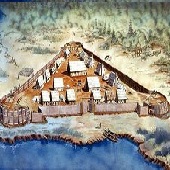 |
The three European nations dominant in colonizing North America were Spain, France, and Great Britain. The first successful English settlement in the New World was Jamestown (aka Fort James), founded by the London Company in present-day Virginia, nearly a century ofter Spain had established its foothold across the Atlantic. Jamestown's survival would not become solidified until almost two decades later. The challenge resulted laregly due to the poor location choice for settlement. The area was low and swampy, subject to outbreaks of malaria; surrounded by dense woods, making it difficult to culitvate; and bordered powerful Indian tribes, initially friendly but nevertheless a potential threat due to culture vastly foreign to that of white Europeans. Another contributing factor was the assemblage of settlers. Most were somewhat well-to-do, unaccustomed and unwilling to perform the manual labor necessary to establish a prosperous colony. During Jamestown's first 17 years of existence, an influx of some 10,000 settlers arrived, continuously bolstering the colony. In 1624, the Jamestown population was only 1,275. Of the 144 men who departed England to found Jamestown, only 104 survived the voyage. Within the first year, just 38 remained. In the spring of 1609, another 600 Englishmen arrived. What was ahead for them was nothing short of horrific. Neighboring Indians, originally friendly but now aggravated by actions of the earlier settlers, initiated what is known as the "starving time." After killing livestock and destroying crops, the Indians essentially held the settlers captive within their own palisades. Only 60 emaciated men emerged from the harrowing winter ordeal (one desperate settler killed his wife and survived on her remains). After 1612, the cultivation of tobacco (encouraged by John Rolfe) and establishment of the supportive "headright system" a few years later would put Jamestown on the path to eventual survival. |
 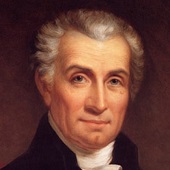 |
As President George Washington left office, he advised the nation against the formation of political parties, but to no avail (his Federalist Party was already being challenged by Thomas Jefferson and the Democratic-Republicans). Starting with the so-called "Revolution of 1800" (Jefferson's reference to the 1800 presidential election), the Democratic-Republicans began a steady ascent to political dominance. So thorough was the incline (and so thorough was the political ineptitude of the Federalists) that by James Monroe's presidency, the two-party system had reverted back, momentarily, to a single-party system. In fact, Monroe ran essentially unopposed for re-election in 1820. So certain was the outcome of the election that many Americans simply did not bother to vote. For example, in Richmond, Virginia, a town of 12,000 people, only 17 men cast votes! Monroe was re-elected one electoral vote shy of unanimous. According to story, the lone elector, William Plumer of New Hampshire, cast his vote for someone else in order to preserve Washington the honor of being the only President elected unanimously. Good story, but not true. In truth, the elector simply didn't care for Monroe in the White House and therefore cast his vote accordingly. Who got the maverick electoral vote? Secretary of State John Quincy Adams, who coincidentally would become America's next President. |
 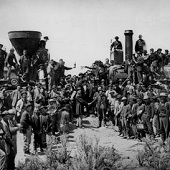 |
Following America's victory in the War of 1812 (aka America's "Second War for Independence"), the nation embarked on a massive wave of expansion on all fronts, not the least of which was significant movement westward in what would become known as "manifest destiny." Although the purchase of the Louisiana Territory from France in 1803 had doubled the size of the United States, there was still plenty more land to acquire (most of it would come at the expense of war with Mexico in 1846-8). Once the vast territory had been secured to form the present shape of the continental 48 states—the final puzzle piece was the 1853 Gadsden Purchase—the government aggressively pursued settlement and economic development of the West. A crucial ingredient was the railroad industry. Since it was initially unprofitable for companies to construct and operate railways through the desolate West, the government would offer subsidies to entice railroads to extend westward. This financial aid came in the form of land. The Pacific Railway Act of 1862 set the precedent by granting to the Central Pacific and Union Pacific five alternate sections (square miles) of public domain on both sides of the track for every mile of track laid. Thus, America's first "transcontinental" railway, stretching practically 1,800 miles from Omaha to Sacramento, was completed in 1869. The gift of free land worked once; why not continue the practice? Before the end of the century, three more government funded railway routes will cross the West. In total, the government gave in excess of 175 million acres of land to various railroads. The sum acreage is equivalent to the states of Ohio, Pennsylvania, New York, and the New England states combined—or an area one-tenth the size of the United States! The federal government contributed about 70 percent; the states roughly 30 percent. |
 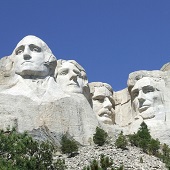 |
Mount Rushmore National Memorial is located in the Black Hills of western South Dakota. The spectacular granite sculpture features the busts of four outstanding Presidents—the selection of which was purely the decision of sculptor Gutzon Borglum. George Washington's likeness was intended to symbolize the founding of the new nation and self-governance, independent of Great Britain. The image of Thomas Jefferson was meant to represent America's democratic political philosophy and the first great period of expansion, when the United States purchased Louisiana from France. Borglum reasoned Abraham Lincoln's portrait would represent preservation of the Union (his paramount purpose for fighting the Civil War) and freedom for all people living in the United States. Theodore Roosevelt appears as emblematic of America's global responsibilities (brought on by the expansionist era) and his devoted conservation of the West. No man-made accomplishment celebrates America's glorification of bigness and technology in grander fashion than the "Shrine of Democracy." Each head is approximately 60 feet tall, which according to scale would compute to a human of some 465 feet in height! Borglum's stone masterpiece rises more than 500 feet above the valley. President Calvin Coolidge was present to christen the work in August of 1927—Borglum himself was hoisted up the cliff to remove the first pieces of rock. Carving was accomplished through controlled blasting with dynamite (scheduled twice daily) and laborious drilling using pneumatic hammers. Workers were often suspended hundreds of feet above ground. Dangerous work it was, but surprisingly, not a single casualty occurred among the nearly 400 workers during the entire construction process! The last details of Mount Rushmore were completed in late 1941, seven months after Borglum's death, by his son Lincoln. Years later, several of the crew members would unfortunately succumb to silicosis, a condition of dust accumulation in the lungs, attributed to their work on Mount Rushmore. |
 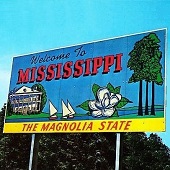 |
After the departure of Radical Republican Reconstruction in 1877 and the implementation of the "separate but equal" doctrine in 1896 under Plessy v. Ferguson, the South fashioned its ruthless regime to deny civil rights while the rest of the country looked the other way. The modern civil rights movement reached a fervent peak during the 1960s when a number of southern states were called to task regarding their brazen endorsement of torture and murder to maintain white supremacy. There was no bloodier civil rights battleground than Mississippi, historically notorious among the Deep South alliance for its refusal to accept black equality in any manner whatsoever. Indeed, the state's actions during the 1950s and 1960s to maintain black subservience were firmly rooted in a loathsome post-Reconstruction tradition of terror that was unparalleled. Between 1880 and 1940, nearly 600 blacks were lynched in Mississippi. No measure of justice was exacted on behalf of the victims in any of these cases—not only were there no convictions or indictments, but astonishingly, not even a single arrest by state law enforcement officials! A century after the Civil War, Mississippi was no closer to racial equality than it was the day Vicksburg fell. As Mississippi's quasi-Confederate methodology proceeded unchecked, blacks were subjected to exalted levels of intimidation—loss of jobs for fabricated reasons, unjustified insurance cancellations, sudden jumps in loan interest rates, immediate mortgage foreclosures, and when all else failed, downright violence and unmerciful cruelty. By 1960, only five percent of blacks living in Mississippi (which comprised over 40 percent of the state's population) had managed to overcome the poll taxes, unfair literacy tests, and threats of terror to register for the vote. There were specific terrorist incidents. In 1962, for example, the Magnolia State attracted nationwide attention when James Meredith attempted to become the first black student at the University of Mississippi. Such violence erupted that Attorney General Robert Kennedy sent 500 federal marshals to take control (days later, Meredith was attending class). During the so-called "Freedom Summer" of 1964, three young northern civil rights activists (one black, two white) were executed by a goon squad of Ku Klux Klaners headed by the local deputy sheriff (some evidence suggests that two state highway patrolmen were tacitly involved, as well). Federal intervention was again required to bring a trace of humanity to Mississippi. |
